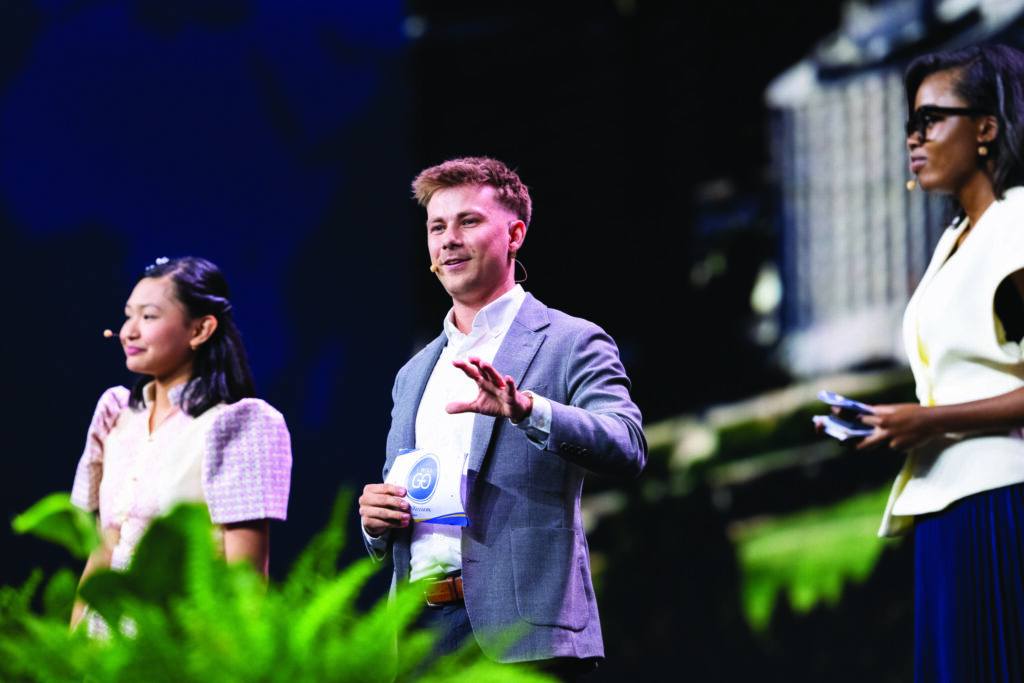Program Highlights Stories of Those Committed to Frontline Mission
“Thank you for joining us,” said Caleb Haakenson, a producer in the Office of Adventist Mission, as he and two other hosts opened the highly visual, multipart program. “Fasten your seat belts, as we’ll be taking you all over the globe to watch stories of people who said, ‘I will go.’ ”

Photo: Mark Froelich
A Global Mission
Gary Krause, Adventist Mission director, reminded the congregation how the arrival of J. N. Andrews as a missionary to Europe in 1874 triggered a golden era for mission, as an increasing number of committed Adventists embraced missionary deployments around the world to share Jesus wherever they went.
Krause shared how 35 years ago the Adventist Church moved from outreach initiatives focused mainly on increasing their membership to others more focused on reaching all people groups around the world. The Global Mission Person to Person program voted in 1990 marked a shift toward a more intentional and conscientious effort to enter unreached areas, establishing an Adventist presence where there had been none, he explained. “For the first time, we started to think not just in terms of geography in our mission but also in terms of people groups,” Krause said. “And we started to think not only about Christians but also about people of other world religions.”
Mission Refocus Windows
More recently the church has embarked on a new initiative called Mission Refocus, which seeks to redirect funds and human resources to three “windows,” or pockets with limited or no Adventist presence. This includes the 10/40 window, a region of the world where most people live but where Christianity is a clear minority; the urban window, focused on the largest cities in the world, and the post-Christian window. The goal is “to start new groups of believers and make disciples for [Jesus],” Krause said.
This also includes the support of Global Mission Centers, focused on connecting and reaching people from the major world religions, including Hinduism, Islamism, Judaism, and others. “It’s where faith meets context, where Scripture speaks to culture, and where hope becomes a lived experience,” a video narrator explained.
Novel Approaches to Mission
For Adventist missionaries it implied going out of their comfort zones and trying new approaches to connecting with people. It’s all about “breaking down barriers that stand in the way of the gospel,” the narrator explained.
For Khamsay Phetchareum, director of the Global Mission Center for Adventist-Buddhist Relations, it meant supporting an initiative of having a burial place for those Buddhists who accepted the Adventist faith. “For those of a Buddhist background, the idea of accepting a new faith that doesn’t offer a dedicated cemetery is distressing,” the narrator shared, explaining that burial ceremonies are considered even more important than weddings.
The center led by Phetchareum is providing these special places across Thailand and other countries and connecting with Adventist families that don’t know where to bury their loved ones. According to Global Mission Centers director ChanMin Chung, this initiative has led to more people being open to the gospel message. “Removing just one barrier can open hearts in a way that preaching alone sometimes cannot,” he said.
Food and Hospitality
In Taichung City, Taiwan, breaking down barriers and connecting with the locals meant opening the Come N See Café in the heart of the central district. The café has become a place where young Taiwanese, especially students, come to connect, explore spirituality, and find a sense of community, leaders behind the initiative said.
“Our customers are our neighbors,” Soonbum Kwon, Korean pastor and the missionary behind the café, said. Kwon, who had experience in Public Campus Ministry working with students in public universities, envisioned moving the ministry off campus as well. With the support of the world church, he opened the café as a place where students could enjoy good food and find Jesus in the process.
Some of the first students who were baptized are now volunteers supporting the ministry, which includes Bible studies, vespers, and other spiritual activities. It also offers Korean language classes, cooking workshops, and social events that attract new customers. “Through our café Taiwanese students and families are getting to know about God’s love,” cook Nam Dong Hyeon said.
Five CEOs Together in Mission
The last part of the I Will Go program included a first-of-its-kind report. The CEOs of the five Adventist health care networks in the United States shared what they are doing to impact the world around them as they strive to follow in Jesus’ footsteps. These included the CEOs of AdventHealth, Adventist Health, Adventist HealthCare, Kettering Health, and Loma Linda University Health.
The CEOs shared testimonies of what the networks they lead are doing to show the love and compassion of Christ with those who need not only physical but also mental and spiritual healing. “Every encounter brings us closer to the sick and hurting,” said AdventHealth president and CEO David Banks of the network that treats 22 million patients a year in more than 100 hospitals and 2,700 medical offices and outpatient clinics. “Mingling with people today means going beyond the walls of our hospitals and treatment centers and deep into our communities.”
The report included stories of people such as Michael, an addict who began to heal when he found someone who cared for him; and Keith, a terminal patient who, through virtual reality technology, fulfilled his dream of “visiting” the Grand Canyon. It also included the story of Richard, a stage 4 prostate cancer patient who found healing thanks to medical research once thought unimaginable; and of Mattie, a baby who underwent a liver transplant after a prolonged coma to eventually recover. “This is the ministry of Adventist health care,” network leaders said. “Until Jesus returns to make all things whole.”
Marcos Paseggi, Adventist Review